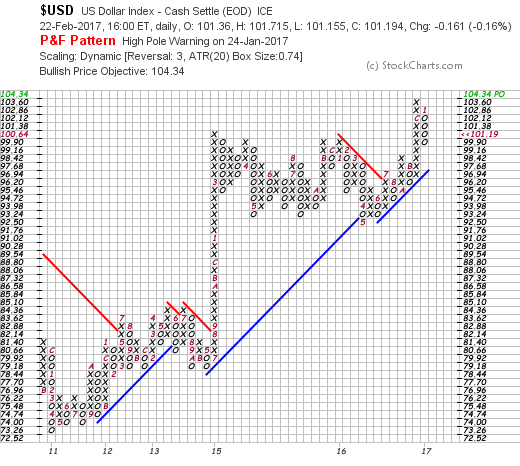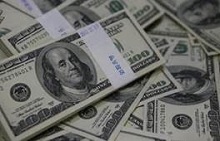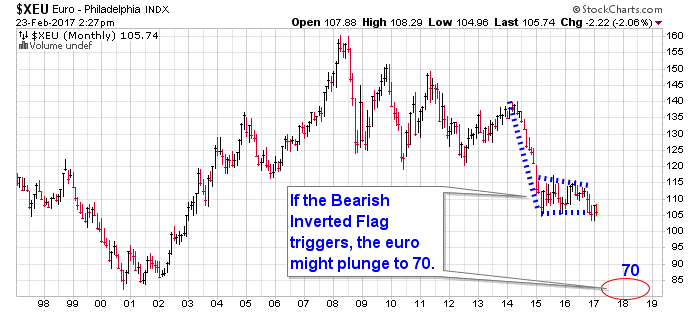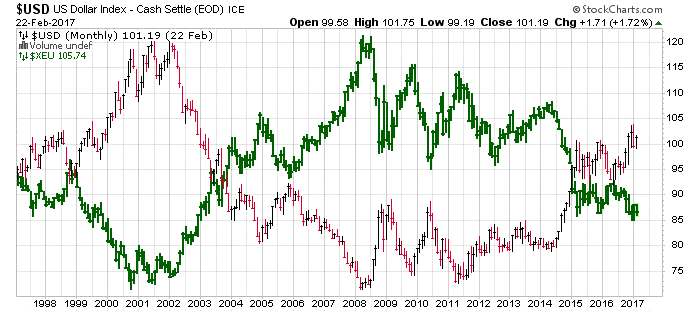Rising Interest Rates Fueling The US Dollar Higher In 2017
Historically How the Fed Funds Rate Hikes Affect The US Dollar
“Changes in the Federal Funds Rate has and will always affect the US dollar. When the Federal Reserve increases the Federal Funds Rate, it normally reduces inflationary pressure and works to appreciate the dollar.
Since June 2006, however, the Fed has maintained a Federal Funds Rate of close to 0%. In the wake of the 2008 financial crisis, the Federal Funds Rate fluctuated between 0 and 0.25%.
The Fed used this monetary policy to help achieve maximum employment and stable prices. Now that the 2008 financial crisis has largely subsided, the Fed will look to increase interest rates to continue to achieve employment and to stabilize prices.
Inflation Of the US Dollar
The best way to achieve full employment and stable prices is to set the inflation rate of the dollar at 2%. In 2011, the Fed officially adopted a 2% annual increase in the price index for personal consumption expenditures as its target. When the economy is weak, inflation naturally falls; when the economy is strong, rising wages increase inflation. Keeping inflation at a growth rate of 2% helps the economy grow at a healthy rate.
Adjustments to the Federal Funds Rate can also affect inflation in the United States. The Fed controls the economy by increasing interest rates when the economy is growing too fast. This encourages people to save more and spend less, reducing inflationary pressure. Conversely, when the economy is in a recession or growing too slowly, the Fed reduces interest rates to stimulate spending, which increases inflation.
During the 2008 financial crisis, the low Federal Funds Rate should have increased inflation. Over this period, the federal funds rate was set near 0%, which encouraged spending and would normally increase inflation.
However, so far in 2015, inflation is still well below the 2% target, which is contrary to the normal effects of low interest rates. The Fed cites one-off factors, such as falling oil prices and the strengthening dollar, as the reasons why inflation has remained low in a low interest environment.
The Fed believes that these factors will eventually fade and that inflation will increase above the target 2%. To prevent this eventual increase in inflation, hiking the federal funds rate reduces inflationary pressure and cause inflation of the dollar to remain around 2%.
Appreciation Of The US Dollar
Increases in the federal funds rate also result in a strengthening of the US dollar. Other ways that the dollar can appreciate include increases in average wages and increases in overall consumption. However, although jobs are being created, wage rates are stagnant.
Without an increase in wage rates to go along with a strengthening job market, consumption won’t increase enough to sustain economic growth. Additionally, consumption remains subdued due to the fact that the labor force participation rate is close to its 35-year low. The Fed has kept interest rates low because a lower federal funds rate supports business expansions, which leads to more jobs and higher consumption. This has all worked to keep appreciation of the U.S. dollar low.
However, the US is ahead of the other developed markets in terms of its economic recovery. Although the Fed raises rates cautiously, the US could see higher interest rates before the other developed economies.
When the Fed increases interest rates, it attracts foreign funds to the US. This leads to a natural appreciation of the US dollar, even in light of stagnant wages and low domestic consumption.
Overall, under normal economic conditions, increases in the Federal Funds Rate reduce inflation and increase the appreciation of the US dollar. In the 2015 economic environment, increases in interest rates will slow the growth of inflation to the 2% benchmark and increase appreciation.”
(Source: INVESTOPEDIA – Late 2015)
What The Fed Is Thinking Today
On February 22. 2017 Philadelphia Fed President Patrick Harker told Market News International he would likely support a quarter point rate increase at the central bank’s March 14-15 meeting.
Fed Chair Yellen: 'Unwise' To Wait Too Long To Hike Interest Rates
“Waiting too long to raise interest rates would be "unwise" as economic growth continues and inflation rises, Fed Chair Janet Yellen told Congress last week.
Repeating caution that she and other central bank officials have issued in recent months, Yellen said that even though the Fed expects to hike gradually and to keep policy accommodative, getting rates back to normal levels is important and hikes will be considered ahead.
Market reaction was prompt, with government bond yields jumping on sentiment that Yellen was teeing up next month's Fed meeting as possible for a rate hike.
"By leaving March rate hike options open, Chair Yellen is sticking with her playbook with repeated reminders that every meeting is in fact a live meeting," said Mark Hamrick, senior economic analyst at Bankrate.com.
The Fed kept its target overnight lending rate near zero for seven years and raised just twice since — in December 2015 and again a year later. The funds rate is currently targeted in the 0.5 percent to 0.75 percent range.” (Source: http://www.cnbc.com/2017/02/14/fed-chair-janet-yellen-unwise-to-wait-too-long-to-hike-interest-rates.html )
What To Expect For Fed Rate Hikes In 2017
“What investors absolutely have to get used to under this post-election cycle into year-end is that the Federal Reserve looks overwhelmingly as though a Fed Funds Rate hike is coming in December. They wanted to avoid any presidential election fallout, but inflation is getting close enough to the Fed’s target of 2.0% to 2.5% and employment is close enough to full that the Federal Reserve almost has no choice but to act.
Even with Janet Yellen offering testimony, the reality is that there were over 20 instances of Fed heads offering up live commentary and making media appearances. Well over half of those are leaning to rate hikes.” (Source: http://247wallst.com/economy/2016/11/19/what-to-expect-for-fed-rate-hikes-in-december-and-in-2017/ )
President Trump's Policies May Lead To Rate Hike Soon: US Federal Reserve
The Federal Reserve said the economy's continued growth might convince it to raise its benchmark interest rate "fairly soon" due to the ambitious policies proposed by President Donald Trump that may have unforeseen effects, the media reported.
The Federal Reserve made the statement recently after officials spent their meeting three weeks ago consumed with the changes brought on by a new administration in the White House, NBC News reported.
The Federal Open Market Committee - the central bank's policymaking arm - discussed at length the impact from lower taxes and regulations and higher domestic spending under President Trump, according to minutes of the January 31 - February 1 session.
The meeting was the first since Trump took office on January 20.
Many participants expressed the view that it might be appropriate to raise the Federal Funds Rate again fairly soon" if data on jobs and inflation are "in line with or stronger than their current expectations", or if the risk increased that the Fed might overshoot its goals, the meeting summary stated.
Jobs numbers indeed have been solid and the Consumer Price Index inflation indicator is at its highest level in years, NBC News reported.
The US Treasury yield curve flattened slightly following the minutes' release, with the short-term two-year note yield trading higher, near 1.23 per cent, and the benchmark 10-year note yield slipping to 2.41 per cent.
One example of the policy dilemma was "upside risks" that would come with "more expansionary fiscal policy or a more rapid build-up of inflationary pressures," as well as the downside risks of an appreciating US dollar.
Most participants continued to see heightened uncertainty regarding the size, composition, and timing of possible changes to fiscal and other government policies, and about their net effects on the economy and inflation over the medium term, and they thought some time would likely be required for the outlook to become clearer," the minutes added. (Source: http://www.newindianexpress.com/business/2017/feb/23/president-trumps-policies-may-lead-to-rate-hike-soon-us-federal-reserve-1573872.html )
Yellen: March 2017 Rate Hike Is On The Table
Federal Reserve Chair Janet Yellen told Congress Tuesday that an interest rate hike in March remains on the table, pushing back against market expectations that the Fed will stand pat.
“Precisely when we take an action -- March, May or June -- I can’t tell you,” Yellen told the Senate Banking Committee. “I would say every meeting is live.”
Fed fund futures say there’s just an 18% chance of a rate increase in March, versus. about 50% in June. The Fed raised its benchmark rate by a quarter percentage point in December to a range of 0.5% to 0.75%. That was its first hike in a year.
In December, Fed policymakers forecast three rate increases in 2017, up from its estimate of two bumps in September, citing an improving economy and labor market.
San Francisco Fed President John Williams recently suggested a March increase is a possibility. And Chicago Fed chief Charles Evans, typically a “dove” who prefers to keep rates low to spur growth, said he officially predicted two rate hikes but could be comfortable with three moves.” (Source: http://www.usatoday.com/story/money/2017/02/14/yellen-march-rate-hike-table/97873408/ )
Fed Likely To Raise Interest Rates At Coming Meetings, Yellen Says
(Source: http://www.marketwatch.com/story/yellen-says-interest-rate-hikes-can-be-gradual-2017-02-14 )
Fed Raises Rates, WSJ Anticipates 3 Fed Rate Increases in 2017
“The Federal Reserve said it would raise its benchmark short-term interest rate for the first time in a year and expects to lift it faster than previously projected in the coming year.”
(Source: https://goldstocksforex.com/2016/12/14/fed-raises-rates-anticipates-3-increases-in-2017-wsj/ )
Yellen Sees More Rate Hikes Ahead If Economy Stays On Course
- ‘Waiting too long to remove accommodation would be unwise’
- She gives no clear signal on timing of Fed’s next move
Janet Yellen signals March Rate Hike Is Possible
(Source: http://money.cnn.com/2017/02/14/news/economy/janet-yellen-federal-reserve-hike-testimony/ )
US Dollar Not Likely to See Major Move During Next Rate Increase…HOWEVER
According to INVESTOPEDIA:
“When the Federal Reserve once again enters a rising rate cycle, do not expect the US dollar to sustain a substantial move. For one thing, as mentioned above, US rate increases have had low to negative correlation with the US dollar, and the U.S. dollar has already sustained a massive rally since late 2014. Since late last 2014, the US dollar index has rallied from around $81 to its current $97.59 in November 2015. At one point, the index was above $100. This is a substantial move in the currency markets, as investors have been highly anticipating a rate increase for the past year. Analysts and market pundits have continually reiterated there is a strong likelihood the dollar’s response to a rate increase could be relatively muted.
The Bottom Line (According To INVESTOPEDIA)
The bottom line is the United States has been in a record low interest rate environment for almost eight years, and the US economy’s sluggish growth actively reflects the current environment. Rising interest rates signal more confidence in the economy, but do not be fooled; rising rates are shown to have less correlation with the US dollar over the past couple of decades. Tie in the fact the US dollar has already seen a massive rally since late 2014 and this leads to the likelihood that investors who are betting on another sustained leg higher in the U.S. dollar rally are likely to be sorely disappointed.”
INVESTOPEDIA Views Are Short-Sighted In Ignoring A Very Crucial Factor (i.e. The Crumbling Euro)
Although INVESTOPEDIA makes some valid observations, it does NOT take into account the tumbling value of the Euro currency and the distinct possibility that the Euro Union (EU) is hell bent for leather heading to dissolution. And in that event, many millions of investors will dump the fading Euro and flee in panic to the heretofore global Reserve Currency…to wit: the US greenback. Indeed and fact the Euro currency has relentlessly lost value vis-à-vis the US Dollar Index during the past nine years (since early 2008). Moreover, there is nothing on the horizon that even hints of a reversal for the ill-conceived and ill-fated EU….Au Contraire: the Euro could plummet to about 70 in the not too distant future (see chart).
(http://stockcharts.com/h-sc/ui?s=%24XEU&p=M&yr=20&mn=0&dy=0&id=p57675734279&a=464369174&listNum=1 )
And as all monetary pundits well know, the US Dollar Index is the inverse of the Euro:
http://stockcharts.com/h-sc/ui?s=%24USD&p=M&yr=20&mn=0&dy=0&id=p56151114575&a=470823105&listNum=1
Short-Term Point&Figure Technical Analysis Is Calling For The US$ To Rise To Nearly 105
As one of the important TA indicators, P&F Analysis should also be considered along with other indicators before taking a position. Nonetheless, P&F is calling for the US$ to rise to 104.34. However, no time frame is given.

http://stockcharts.com/freecharts/pnf.php?c=%24USD,PLAADANRBO%5bPA%5d%5bD%5d%5bF1!3!1.0!!2!20
Rest assured that as US interest rates rise in 2017, so eventually will the US Dollar strengthen.
Related Research
Effects Of Interest Rates And Value Of The Dollar On Gold Price
Possible Implosion Of Euro Currency In 2017 And Its Impact On US Dollar
US Dollar Will Strengthen As Fed Funds Rate Rises
********




















